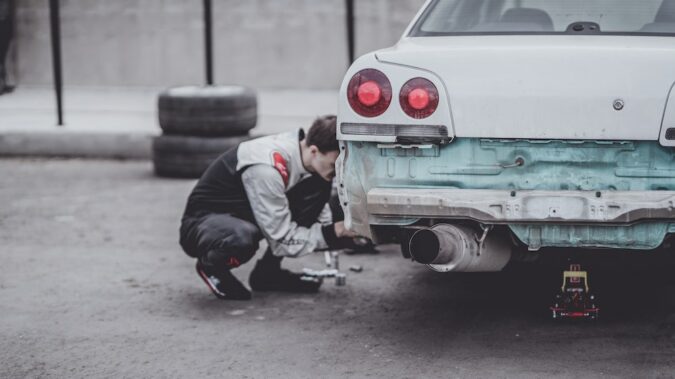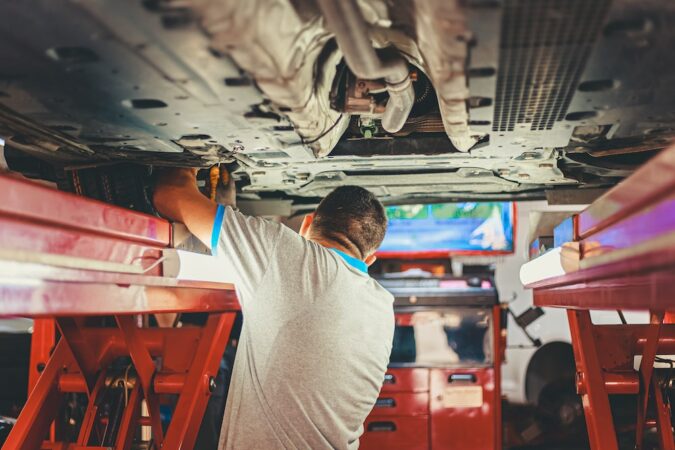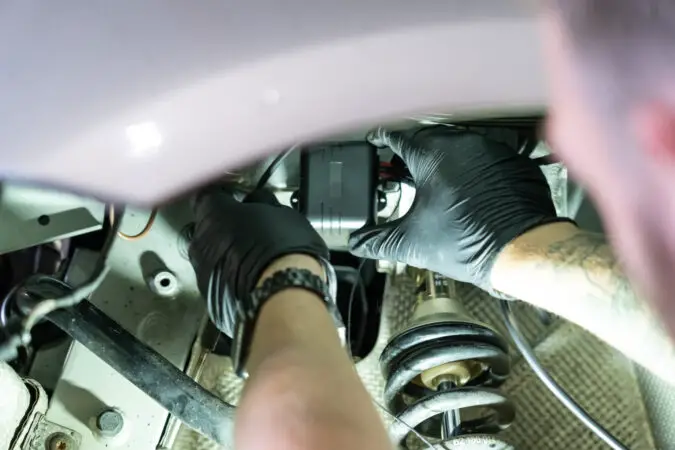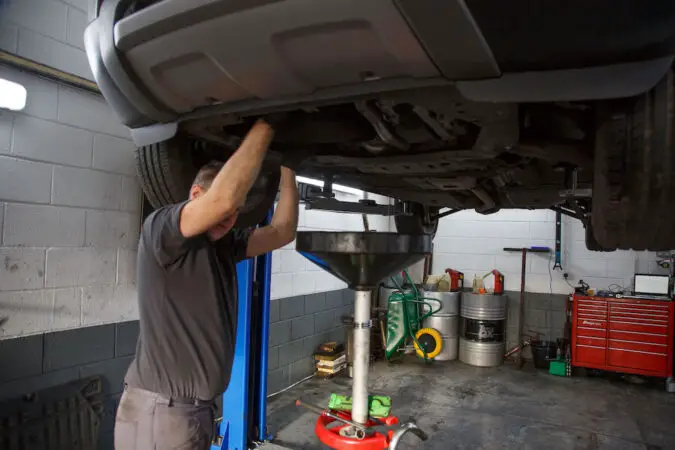Before being released into the atmosphere, engine fumes are cleaned by an exhaust system. Without one, health and environmental risks would exist for both the environment and people. But what is the cost to replace the exhaust system?
Depending on the style, size, and individual components of the exhaust system, the price of an exhaust system can range from $300 to $1200.
This is merely a superficial scratch. We’ll look into the exhaust cost to replace an exhaust system and the factors that affect it in more detail later on in this article. So let’s start without further ado!
- Exhaust Pipe Repair
- Leak Repair Cost
- Broken Exhaust Pipe
- Rusted Exhaust Pipe
- Frequently Asked Questions
Exhaust Pipe
The function of the exhaust is to expel the burned air-fuel mixture out of the engine. But the effort doesn’t stop there. This pollution must also be cleaned, and the noise must be reduced, via an exhaust system.
The design of this system has an impact on your car’s overall performance, hence it counts. Learn more about the exhaust system’s operation and necessity by reading on.
Components For An Exhaust System
As is customary, we must first examine the components of an exhaust system before examining how they operate.
1. Exhaust Manifold
An exhaust manifold is responsible for gathering the exhaust gases and kiting them into a single pipe. It connects directly to the engine and is the initial component of an exhaust system.
2. Oxygen Sensors
After the manifold and after the catalytic converter, there are two sensors. Their responsibility is to detect the oxygen content of the exhaust gas.
3. Exhaust Pipings
These link to various components of the exhaust system and are frequently made with high pressure in mind.
4. Catalytic Converter
The component that comes after the exhaust manifold is responsible for removing dangerous exhaust gases like NOx and CO.
5. Resonator
The resonator, which is not found in all vehicles, comes straight after the catalytic converter. It reduces the noise over a specific frequency.
6. Muffler Or Silencer
You may already be aware that mufflers will lessen the noise. It functions for a greater variety of sounds than a resonator, which makes it different. To find out more, check out our overview of what is a muffler on a car.
7. Exhaust Pipe Tailpipe
It serves as the exhaust system’s capstone. The car’s exhaust gases are ejected by it.
How An Exhaust System Operates
Exhaust gases come out of a combustion engine after the fourth cycle. The exhaust manifold is attached to the engine and constructed with pipes entering each cylinder.
It only produces one output. The manifold gathers all of the exhaust gases simultaneously from several chambers and pushes them into a single pipe. A poppet valve regulates the exhaust manifold’s opening and closing.
Following collection, the exhaust gases are sent to the catalytic converter. Stock piping has needless tapers that alter exhaust gas pressure and can result in back pressure, which lowers performance.
This is done to reduce the cost of the automobile. After we have finished working on the exhaust system, we will talk about this.
To measure the amount of oxygen in the exhaust gas, oxygen sensors are utilized. Less oxygen indicates excessive fuel consumption, while too much oxygen indicates insufficient fuel consumption. The TCU receives this information and modifies the fuel delivery as necessary.
Catalytic Converter
The complicated catalytic converter employs chemistry to transform dangerous NOx and CO into simple, harmless gases. It uses both reduction and oxidation to break down the gases.
When a NOx particle passes through the catalyst, reduction happens. For more insight, check out our explainer on what’s in a catalytic converter and what’s a catalytic converter. The converter breaks down the NOx particle into the innocuous gases N and O.
Reduction is the result. As soon as a CO particle passes through, oxidation happens. The catalyst changes CO into CO2, which is safer than CO by adding another O. The catalytic converter purifies the exhaust gases in this manner.
After the catalytic converter, there is a second oxygen sensor for the same purpose.
It confirms that CO2 and oxygen are truly the gases coming out of the catalytic converter. If it discovers something different, it alerts the ECU that there may be a problem with the catalytic converter.
Resonators, however not often utilized in automobiles, lessen some of the annoying sounds when driving.
By delivering a sound with the same frequency but an opposite wavelength, mostly reduces noises like droning sounds. This eliminates the noise and cancels out the frequency.
Exhaust Pipe Repair
An exhaust leak can disrupt the engine’s smooth operation and decrease fuel efficiency. Loud noises are a common sign of leaks. However, they might also set off the check engine light or let poisonous vapors into the cabin.
You may require a new exhaust pipe if the current exhaust is corroded severely. That said, if it’s a small leak, there isn’t any need to spend unnecessary cash. The good news is that it’s possible to repair any leak using readily available materials without the need for welding.
Exhaust Cost To Replace, Steps For Repairs #1 – Materials You’ll Need
Leaks can be sealed without spending a lot of money. All of the supplies listed below are easily accessible at your neighborhood store.
- Hand mitts
- Sandpaper
- Steel-wire broom
- Clean water
- Putty
- Exhaust bandage
- Band clamp for exhaust
Exhaust Cost To Replace, Steps For Repairs #2 – How To Locate A Leak
When done correctly, fixing a leak is simple, though it is frequently the most difficult step. When the engine is idle, listen for any variations in sound to see if there is a leak.
Use one of the following techniques to flush the leak out once you have determined that the pipe is dripping.
1. Examine The Pipe
Lift the car up and check the exhaust for any indications of rust, holes, or other damage. Potholes, speed bumps, and other roadside debris can harm the exhaust pipe if they get caught there. Therefore, be sure to examine the vehicle’s undercarriage for leaks.
2. Exhaust Underchassis
Move your hand over the pipe while the engine is running to check for damage if it cannot be seen. When the released air strikes your hand, you can see if there is a hole.
To prevent burns, you should never put your hand—or any other part of your body—on the hot exhaust surface. Before you slide under the car, make sure you engage the emergency brakes as well.
3. Connect The Tail
Start the engine after plugging the exhaust tail with a pair of gloves. Press the throttle pedal after making sure you engage the emergency brakes.
The exhaust system will begin to experience pressure buildup. The gasses will also escape through the leaks since there is no other way to do so. To find tiny leaks more quickly through air bubbles, spray soapy water around the exhaust pipe.
You can force air into the exhaust system to produce positive pressure there if you don’t want to keep your engine running. It can be done using a shop vac, air compressor, or leaf blower.
Make sure to seal one of the entrances if your car has two. Before putting cool air into the exhaust, be sure the engine is cold. Your vehicle’s parts could deform or crack if it cools quickly.
Exhaust Cost To Replace, Steps For Repairs #3 – Preparation
You must first clean the region to provide a good bonding surface before repairing the exhaust pipe without welding. To get rid of any grime, grease, or rust, use sandpaper or a metal wire brush.
After that, wipe the area where you scraped with isopropyl alcohol using a cloth and the surface.
Exhaust Cost To Replace, Steps For Repairs #4 – Steps To Stop The leak
There are four different ways to stop a leak. The choice you make will depend on the type and extent of the damage. Let’s begin straight away.
Exhaust Cost To Replace, Steps For Repairs #5 – Apply An Epoxy Bond
You can use epoxy to stop the leak if the hole is tiny enough. After cleaning the surface, mix the epoxy thoroughly by stirring it, then apply it to and surrounding the hole.
You can apply a sealant to the troubled area using a wooden dowel. The rate of curing will vary depending on the product. To find out how long you must wait for it to dry before starting the engine, read the directions carefully.
Exhaust Cost To Replace, Steps For Repairs #6 – Cover It With Duct Tape
If you have a larger hole, exhaust tape is the best option. Make sure to extend the tape a few inches on either side as you wrap it around the hole. To effectively seal the hole, use at least two layers of tape.
Be sure to read the directions in advance because different exhaust tapes call for different application techniques. Some need the engine to be warmed up beforehand, while others need to be wet before use.
Exhaust Cost To Replace, Steps For Repairs #7 – Use An Exhaust Clamp
Use an exhaust clamp to hide the hole or damage if it is not too severe. The procedure is simple to follow. Just fix the bolts and tighten them to cover the hole after wrapping the clamp over it.
The clamp will likely outlive the exhaust pipe because it is composed of stainless steel.
Exhaust Cost To Replace, Steps For Repairs #8 – Use An Aluminum Patch To Patch The Hole
You can use a patch of aluminum to fix holes of any size. After assessing the amount of damage, cut a slightly larger metal patch with a pair of sturdy scissors.
For tiny holes, you might just need to cut a small bit of aluminum. For better sealing in bigger spaces, wrap the pipe with aluminum.
Apply epoxy to the area surrounding the leak. Don’t use too much so that it leaks into the exhaust pipe; just enough to seal the repair.
Depending on the damage, either place the patch directly over the leak or wrap it around the exhaust pipe. After that, apply epoxy to the patch’s edges using a wooden dowel. If you completely encircle the pipe with the patch, use hose clamps to hold it in place.
Exhaust Leak Repair Cost
It is simple to see the advantages and savings in time and money when you repair a leak rather than when your exhaust system needs to be entirely or partially replaced.
For this reason, preventing problems before they arise is preferable to fixing them after they arise.
If, however, the warning indicators of a vibrating gas pedal, dark smoke coming from the tailpipe, a burning or sulfurous odor, or a popping or tapping sound were disregarded, what would happen? If so, you might need to replace the exhaust system as a whole.
Parts can add to the expense as well, depending on what you need to change. For a Nissan Altima, repairing the exhaust manifold gasket would cost between $400 and $500, not adding labor expenses or other fees.
While the price to repair an exhaust leak ranges from $100 to $400, the exhaust cost to replace is anywhere from $150 to roughly $1200. This is assuming an average hourly rate of $100.
If you don’t fix an exhaust manifold leak right away, it could do serious harm to your engine. A burnt exhaust valve brought on by a leaking exhaust manifold gasket might result in combustion chamber exhaust flowing in the wrong direction into the intake manifold.
It is simple to replace a leaking exhaust manifold gasket on front-wheel-drive vehicles with lower displacement engines and the majority of rear-wheel-drive vehicles with engines.
What’s Required
As previously said, changing the gasket responsible for an exhaust manifold leak is simple. To remove the manifold, you’ll need a few wrenches or deep sockets.
You’ll also require a tool to get rid of the previous gasket’s remnants. For this, Emery cloth or any very light grit sandpaper is ideal, but we’ve discovered that a small scraper works best, especially in confined spaces.
These scrapers are available at Home Depot and Lowe’s.
Labor Charges
To calculate how many hours of labor to bill for each given repair, the majority of shops often utilize a part and labor guide. This kind of repair typically takes two to three hours.
Exhaust cost to replace should cost between $160 and $270 in labor because the majority of independent shops charge between $80 and $90 per hour. At a dealership, where labor costs about $110 per hour, you might anticipate paying between $220 and $330 for labor.
Of course, there won’t be a labor charge if you decide to fix the leaky gasket yourself, and you’ll pick up a new skill for yourself.
Broken Exhaust Pipe
Here are some of the potential issues associated with a broken exhaust…
1. Failed Emissions Testing
The most common symptom of a broken exhaust is that your automobile will fail its emissions test; according to one study, malfunctioning exhausts account for about 7% of emissions test failures.
An exhaust system must be free of significant leaks and corrosion, properly fastened to the vehicle, and equipped with the appropriate number of silencers for the make and model in order to pass an emissions inspection.
Advanced corrosion, especially when a leak occurs, silencer baffles that are missing, that are intended to keep engine noise as low as possible, as well as loose exhaust mounts, where there are missing rubber fastenings or they are damaged, are some common exhaust defects that can result in an emissions failure.
The issue is that, prior to an emissions test, it can be very challenging to accurately inspect the state of your car’s exhaust in the driveway. Because of this, it’s crucial to be mindful of any odd noises you hear while driving because they could indicate an unnoticed exhaust leak.
2. Higher Emissions And Lower Fuel Economy
Exhaust systems direct fumes away from the front of the automobile, lessen engine noise and optimize the vehicle’s fuel economy.
Your car’s exhaust leak will affect the pressure in the exhaust system, lowering fuel efficiency and increasing pollutants.
Six gases come out of the exhausts, of which three are harmful (carbon monoxide, nitrogen monoxide, and nitrogen oxide).
To make your automobile function more efficiently, the system diverts these fumes and lowers the number of dangerous particles released from the exhaust.
Fuel waste may result if an exhaust leak close to the engine develops because it can significantly reduce fuel efficiency.
Therefore, even though you may believe that putting off having a leaking exhaust fixed will save you money, the low fuel efficiency may really end up costing you more in the long run.
3. Damage To Additional Auto Parts
The exhaust fumes that seep from a damaged exhaust pipe will eventually harm nearby components and may possibly start a fire.
Exhaust gases are highly hot when they first exit the engine but gradually cool as they travel to the tailpipe at the back of the car.
Such hot gases can find their way out of an exhaust hole next to the engine and blast directly at other parts, resulting in heat damage and raising the possibility of a fire.
Depending on where the hole is in the exhaust system, the leaking exhaust fumes will affect the different objects beneath the automobile. The impact on adjacent components will be less severe the closer the hole is to the exhaust.
4. Toxic Fumes May Enter The Cabin
Poisonous gases could enter the cabin as one of the most dangerous effects of an exhaust system leak, which is definitely bad news for anyone traveling inside!
Toxic gasses like carbon monoxide and nitrogen oxide might make the driver and passengers sick or, in extreme cases, even die if they seep up through the floor or enter through the air vents.
You won’t notice dangerous exhaust fumes in the air until you start experiencing some of their consequences because they have no scent and no color.
Exposure to exhaust fumes could result in headaches, lightheadedness, and weariness, which can be hazardous when operating a vehicle. Additionally, in severe cases, continuous exposure to high quantities of carbon monoxide can result in mortality, making urgent exhaust repairs necessary.
5. Higher Repair Costs
The plain truth is that if you put off fixing a damaged and leaking exhaust system, it will ultimately end up costing you more in the long run.
However, if you wait too long, it will expand to become an unrepairable hole, leaving you with no alternative but to have the part replaced—and costing you much more than you anticipated!
You can prevent most minor cracks and leaks using a solution like Gun Gum Paste before they get worse.
Rusted Exhaust Pipe
All contemporary exhaust pipes are rust-resistant, but this simply delays what will eventually happen.
The easiest method to prevent rust from forming on your exhaust pipe is to take preventative steps, but if you already have a rusty exhaust, here are some suggestions to assist you to clean it.
You can clean your exhaust yourself in a number of methods, and the good news is that most of them don’t require you to acquire any specialized or pricey equipment.
The outcomes you will get entirely depend on how badly the rust has damaged your exhaust pipe.
Vinegar
A piece of old cloth soaked in vinegar would be a better option if you are concerned about scratching the exhaust’s appearance.
Although the acid in the vinegar helps to remove the rust’s particles, it is not strong enough to harm the pipe’s metal. The most effective vinegar is typically white vinegar.
Wrap the rusty section of the exhaust with a cheap dishcloth or an old rag after soaking the rag in vinegar. The outcomes will be better the longer you leave the cloth in place.
After giving it some time to settle, remove the towel and use water to wash the pipe to remove the loose rust. There ought to be a noticeable improvement.
Coca-Cola
Coca-Cola is a good alternative to white vinegar if you can’t find any. Like vinegar, it includes phosphoric acid, which can eat through rust particles without harming the exhaust pipe itself.
You will get the best results by removing the entire exhaust and immersing it in a pail of Coca-Cola for several hours every day or two. After allowing it to soak for a long time, clean the exhaust with a damp towel.
When it comes to removing the rust from your exhaust pipe, none of these techniques will be very effective. You are highly unlikely to ever get your exhaust to look brand new again once rust has started to grow on it.
You may only have one choice left to you if you try several of the procedures mentioned above and are still unsatisfied with the results: a new exhaust.
The only way you’ll likely be able to accomplish the ideal aesthetic is probably by changing the complete exhaust pipe. The procedures mentioned above will assist to create a noticeable improvement, but if a big quantity of rust has built up, you most likely won’t be able to completely remove it.
Frequently Asked Questions
What Is A Muffler
Mufflers help to reduce engine noise and emissions from vehicles. To ensure protection from the chemicals and heat from the exhaust, they are built of steel and covered with aluminum. Mufflers are mainly used to hold down the loud noises that the engine’s pistons and valves produce.
How Much Does It Cost To Straight Pipe A Car
A vehicle with straight piping will normally cost from $1,000 as well as $2,000 to complete. This also includes installation fees and the straight pipe kit. You will save between $100 and $200 if you decide to do it yourself.
How Much Does It Cost To Fix An Exhaust Leak
This kind of repair typically takes two to three hours. This should cost between $160 and $270 in labor because the majority of independent shops charge between $80 and $90 per hour. At a dealership, where labor costs about $110 per hour, you might anticipate paying between $220 as well as $330 for labor.











